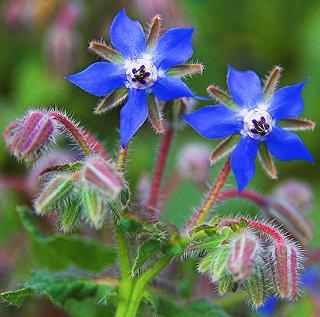
Type: Seed (annual, freely seeding)
Sun Requirements: Full to partial shade
Best Planting Time: Spring for summer flowering or fall for spring flowering
Important Characteristic: Covered in stiff, prickly hairs – can be irritating to the skin
Attracts: Pest-killing wasps and bees – GREAT for asssiting in the pollination of other plants
Repels: Tomato hornworms and cabbage worms
Pests: No significant pests
Companion Plants: – FAVORABLE – Tomatoes, squash and strawberries
Soil Benefits: Reputed to add trace minerals; contains calcium and potassium (can be used in compost piles)
Planting borage is as easy as putting seeds into well-drained ordinary soil – it does not do well as a transplanted seedling. Like many herbs, borage will seed itself year after year, and it is up to the gardener as when and what to thin out as far as new-growth seedlings are concerned. It has no particular soil needs and is quite hardy in ordinary soil. It enjoys full sun, but will tolerate partial shade.
The flowers of borage are bright blue and pleasing to the eye. It’s leaves tend to be dark green and both leaves and flowers taste like cucumbers. As the plant ages, both the flowers and leaves develop prickly hairs, so it is important to pick these prior to these hairs developing. At full maturity, borage can grow between 16 and 32 inches tall and between 8 and 20 inches around. It is not a small plant and given that it freely seeds itself, needs management over time.
Try freezing the freshly cut flowers in ice cubes for a fancy drink addition!

